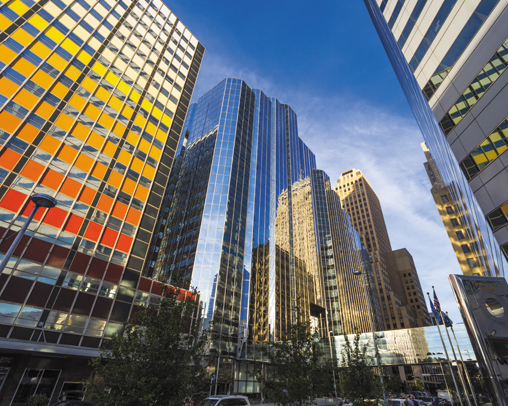by Asif Lakhani
In 2020, Oklahoma City will officially open the brand-new Oklahoma City Convention & Visitors Bureau in downtown, just steps away from Chesapeake Energy Arena where the NBA’s Oklahoma City Thunder play. The new convention center has 200,000 square feet of exhibition space, 45,000 square feet of meeting space, and 30,000 square feet of ballroom space. It cost $288 million to build and was funded by a limited-term sales tax called the MAPS program, which pays for debt-free development of capital improvements.

PAUL BRADY PHOTOGRAPHY/SHUTTERSTOCK.COM
LOCAL INVESTMENTS
Next to the new convention center is Scissortail Park, an urban park that sits on 70 acres of land, which opened at the end of September 2019. Both developments are accessible via the Oklahoma City Streetcar, another project in the MAPS program. The OKC Streetcar runs on a 4.8-mile track that connects Oklahoma City to the Bricktown, Midtown, and Automobile Alley districts. It works in conjunction with the city’s EMBARK public transit system.
The streetcar project cost $135 million to build and has generated $1.6 billion in public and private investments along its route since it was announced in 2011, according to Visit OKC. Construction was officially completed in 2018. Not only have the streetcars made mobility more accessible for Oklahoma City residents, they also have helped establish approximately 5,700 jobs and seven new hotels with 833 rooms total, according to its website. Individual fares cost $1, while a day pass costs $3.
THE HOSPITALITY CONNECTION
In addition to the public-facing endeavors, Oklahoma City is also opening a four-star, full-service Omni hotel in 2020 that will be attached to the new convention center. Omni received an $85.4-million commitment from Oklahoma City as part of the hotel agreement, according to a press release from Visit OKC. Oklahoma City’s 36-percent share of the development cost is competitive compared to deals in similar cities. Oklahoma City has established municipal bonds and a revenue stabilization plan using 10 funding sources to pay off the bonds over 25 years. The hotel will generate four of the revenue sources that will cover more than half of the city’s cost, which are hotel and property taxes, sales taxes, hotel occupancy taxes, and a state match on the latter two taxes.
With all the new developments and innovative urban planning, Oklahoma City has become a leading example of the next-generation American city. It is growing at a healthy rate and has a thriving economy and properly placed resources in position to support its development. With an average of more than 300 days of sunshine a year, Oklahoma City is able to host more than 213 festivals and events and sustainably support more than 100 attractions annually. Tourists and investors alike have no shortage of ways to spend their time and money in Oklahoma City in the near future, especially with the openings of Sccissortail Park and the new Oklahoma City Convention & Visitors Bureau primed to bolster those investments for years to come.
Hospitality is the fastest-growing segment of Oklahoma City’s local economy. The Oklahoma Travel Industry Association says that, based on GDP, tourism is the third-largest industry in the state. As a matter of fact, tourism generated $1 billion in tax revenue for the state of Oklahoma in 2017, according to OTIA. The Greater Oklahoma City Chamber estimates visitor spending accounts for $2 billion of annual spending in the metro area. As of March 2018, Oklahoma City had more than 17,000 total hotel rooms in the city and just under 3,000 in downtown specifically, according to Visit OKC. Tourism and hospitality employ more 31,500 people in the state.



